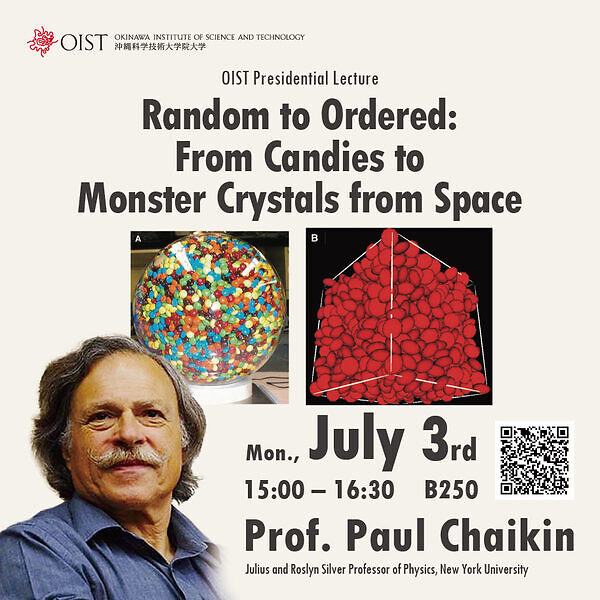Presidential Lecture: Random to Ordered: From Candies to Monster Crystals from Space by Prof. Paul Chaikin

Date
Description
The densest packing of spheres, although known for millennia to be a Face-Centered Cubic (FCC) crystal with volume fraction φFCC ~0.74, has only recently been proven mathematically (2014). An equally ancient problem is “Random Close Packing”, RCP, the densest packing of spheres poured into a jar described in Biblical times (Luke 6:38, KJV) as, “pressed down, and shaken together, and running over”. RCP has escaped a noncontroversial definition although many experiments and simulations agree to a value φRCP ~0.64. We have found that a simple model, “Random Organization”, RO, exhibits a dynamical phase transition between absorbing, 'dead', and active states that appears to have RCP as its critical endpoint. Invented to understand a reversible to irreversible transition in sheared colloids, RO finds RCP with emergent properties such as, randomness, isotropy, isostaticity, hyperuniformity and jamming. To close the book on the crystalline phase, we grew a single crystal on the international space station which found that FCC is the equilibrium structure as compared to the hexagonal close packed and the many other structures with φmax ~0.74
About the speaker
From Brooklyn Paul Chaikin went to Stuyvesant HS in NYC, to a physics BS from Caltech (1966), to a physics PhD from UPenn in (1971) with a thesis on Kondo superconductors. He joined the physics faculty at UCLA in 1972 and studied thermopower, charge and spin density waves, and high magnetic field phenomena mostly in organic superconductors. The lore of actually seeing the microscopics of a system led him into soft matter where he helped develop techniques to measure elasticity and motion and understand interparticle interactions. Both hard and soft matter interests continued after joining the faculty at UPenn (1983), the staff at Exxon Research (1983) and the faculty at Princeton (1988). His interests in geometry and topology led to founding contributions to nanolithography with diblock copolymers, and studies of defect motion and annealing. Probably his most well known contribution is showing that ellipsoids (e.g. M&M’s© ) pack more densely than spheres and helping to explain why. In 2005 he helped found the Center for Soft Matter Research and joined the faculty at NYU. His more recent research centers on photonic non-crytals, artificial active matter, colloids, self-assembly, self-replication, DNA nanotechnology, topological defects on curved surfaces and quantifying order in non-equilibrium phenomena.
Chaikin is a Julius and Roslyn Silver Professor of Physics at NYU, Henry DeWolf Smyth Prof. of Physics, Emeritus at Princeton, a member of the National Academy of Science and a Fellow of; the American Academy of Arts and Sciences, the American Physical Society and the Institute of Physics (London). He was an A. P. Sloan Foundation Fellow and a John Simon Guggenheim Fellow and received the 2018 Oliver E. Buckley Condensed Matter Prize from the American Physical Society. With Tom Lubensky he co-authored the text “Principles of condensed matter physics”.
Subscribe to the OIST Calendar: Right-click to download, then open in your calendar application.



